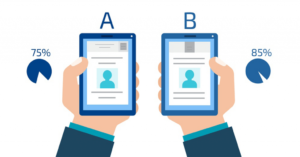Why You Need To Do A/B Testing | Marketing 101

When marketing gurus create landing pages, design call-to-action buttons, or write email copy, it can be tempting to use intuition to predict what will make customers click and convert. But basing important marketing decisions on a “feeling” can be detrimental to your results.
Rather than relying on assumptions or guesses to make these essential decisions, you are much better off running an A/B test — sometimes called a split test.
A/B testing is valuable because different audiences behave differently and something that works for one brand may not necessarily work for another. That’s why conversion rate optimization (CRO) experts despise the term “best practices” simply because it may not be the best practice for you, specifically.
A/B tests can also be intricate, and if you’re not careful, you may make incorrect assumptions about your visitors — crucial decisions that could easily misinform other parts of your marketing strategy.
What is A/B Testing?
In a nutshell, A/B testing is a way to compare two versions of an email, web page, or other marketing asset and measure the difference in how they perform.
You do this by giving one version to one group and the other version to a different group. Then you can see how each variation performs. It’s best to think of it as a competition — you’re pitting two versions of your assets against one another to see which comes out on top.
Understanding which marketing asset works better can help inform future decisions regarding email copy, web pages, or other campaign assets.
How Does A/B Testing Work?
Conducting an A/B test requires performing a series of steps you might see in a scientific study. Like any scientific experiment, you’ll pick one variable to test. Your variable can be anything you like: the color of a banner ad or the placing of a navigation menu.
With A/B testing, the possibilities for maximizing your marketing campaign and website’s full potentials are at your fingertips. Here are the steps for conducting an insightful A/B test. Once you’ve picked your variable, you:
- Develop your hypothesis. (What do you expect from the result?)
- Create a “control” and a “challenger” group based on chosen criteria.
- Randomly split your sample groups into equal-sized sub-groups.
- Determine your sample size (if applicable to your test).
- Define what qualifies as a statistically significant result.
- Make sure you’re only running one test at a time on any campaign. (Running more than one test at a time can compromise results, rendering your test pointless.)
To illustrate how A/B testing works, here are some examples.
Example #1: Imagine you have two different slogans, and you want to know which one converts more customers.
After you create your slogans, you give one to Group A, and you send the other to Group B. Then, you analyze how each performed using metrics, such as click-throughs and sales.
Example #2: For this example, imagine you have four landing page variations, and you want to see which converts more customers.
Just like the first example, you provide one landing page (LP) to each group. Then, you see how each LP performed using metrics such as clicks, traffic, or conversions. You can then start digging into why that is, which will help you to create more effective landing pages in the future.
Conducting Your Own A/B Test: Do’s and Don’ts
A/B testing is extremely beneficial for businesses at any stage. But if you’re unfamiliar with it, A/B testing can be an overwhelming project to start. While you want to use logic and basic user psychology to conduct your tests, sometimes it can be surprising what actually works and what doesn’t. Here are five dos and don’ts of A/B testing.
DO: Test Multiple Variables
Variables that can influence the conversion and sales of your website are not scarce. They are always available for testing on different grounds. For instance, you can effectively test these variables:
- Size
- Color
- Offers
- Subject line
- Layout
- Templates
- Messaging
- Images
- Checkout process
- Navigation
Identify and test as many variables as you can. The more variables you test, the better insights you gain in your marketing strategy.
DO: Test Simple Variables To Start Off
Rather than diving in headfirst, dip your toes into the A/B testing pond by testing something simple like your offer or call-to-action. There’s nothing wrong with simple tweaks before gradually advancing your approach.
DO: Always Be Testing
You should always be testing something. If you happen to have the bandwidth to do so, you can try to run two tests at once. For one test, measure the effectiveness of the CTA on one page. In another test, measure the layouts of two other pages.
The more data you can generate at one time, the more quickly you can optimize your marketing efforts.
DON’T: Test All Variables at Once
Marketers that use A/B testing understand the importance of focusing on just one variable during each test. If you’re testing the effectiveness of one offer over another and you modify different variables, how will you isolate the reason one offer is more effective?
Stick to one variable per test, so there is absolutely no guesswork involved in determining why one test subject worked better than another.
DON’T: Be Afraid To Level Up With Advanced Testing
Once you feel comfortable with simple A/B tests, don’t hesitate to graduate to more complex tests such as A/B/C tests, page-level test designs, mobile testing, and so on. Advanced testing structures will provide two almost completely different page designs to test.
How Can A/B Testing Help My Conversions?
Accurate A/B tests can make a major difference in your conversions and, ultimately, your bottom line. Using controlled A/B tests and gathering empirical data, you can figure out exactly which tactics work best for your brand and your product or service.
When you figure that one marketing mix might work better than another, the idea that you would conduct promotions without testing starts to seem a bit ludicrous.
The Bottom Line
A/B testing is arguably one of the most powerful ways to strengthen sales and marketing efforts. It gives you guidance on the tactics that convert the most customers and shows you which messaging brings you your most valuable customers.
When you pair your A/B testing with a web analytics solution, you’ll be able to segment your data in a way that makes the most sense for your company. That way, you can make smarter decisions that boost your bottom line.
Sources:
A Refresher on A/B Testing – HBR 2017
3.1 Factors That Influence Consumers’ Buying Behavior – Principles of Marketing


